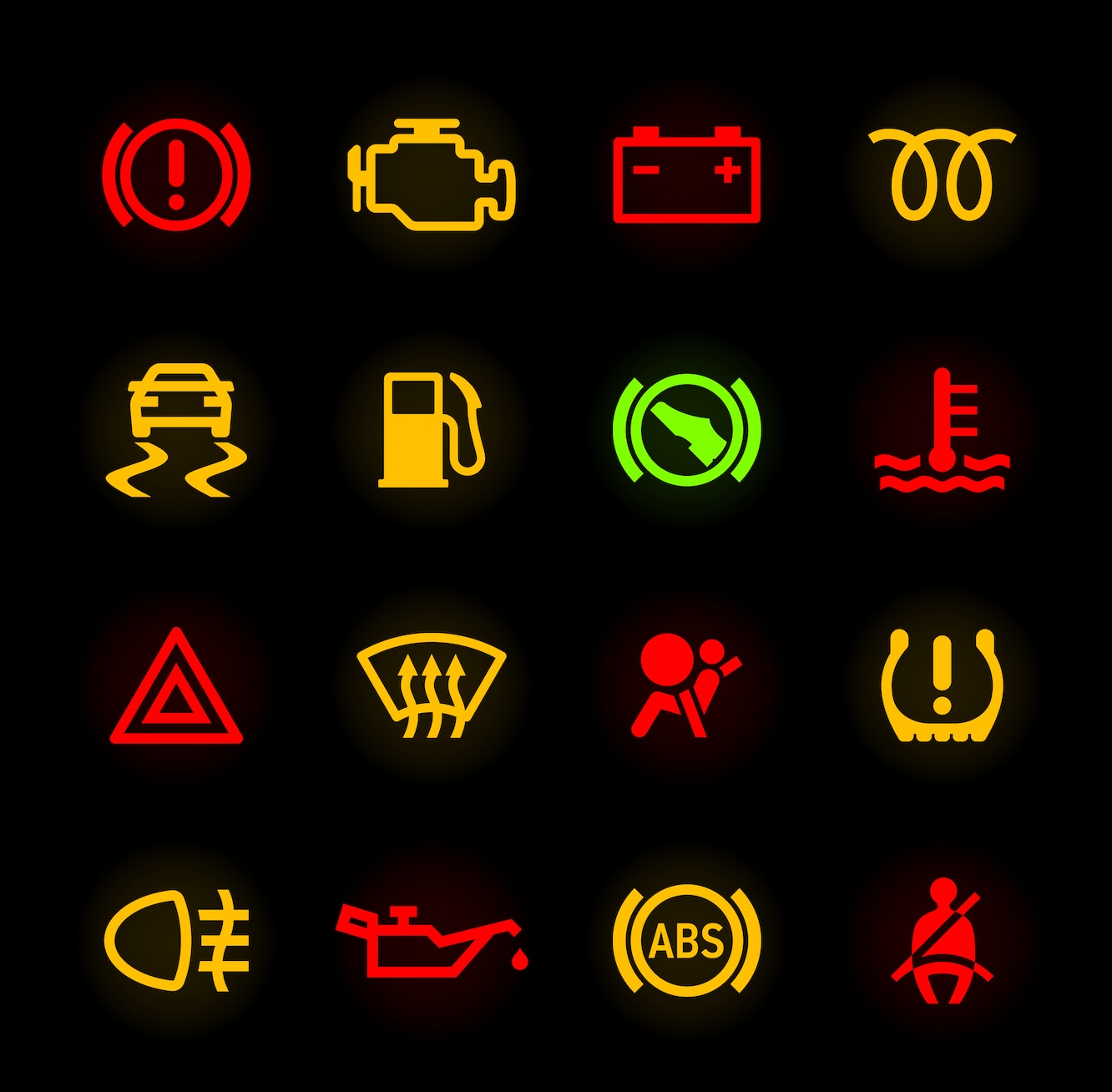Warning Lights you Should Know
There is a section in your vehicle's Owner's Manual that explains what all the icons for various warning lights mean. These are the small lights that appear on your dashboard when your car is trying to tell you something. Lots of people don't really read their Owner's Manual from cover to cover, so we decided to offer up this simple primer on what all these symbols mean.

Dashboard Iconology
Did you know that the instrument panel, or dashboard, on our vehicles today originated with the horse and buggy? The piece of wood across the front of the wagon was meant to keep mud or debris, known as "dash", from getting all over you and your clothes. This was called the "dashboard" and when the horseless carriage came along, the name stuck and evolved to be the panel in front of the steering wheel on modern cars.
Likewise, dashboard warning lights have been with us since the early 1930's. One of the first was known as "the red jewel" adorning the 1933 Hudson Super Six. This generator warning light would turn off once the vehicle started moving but a flashing red light meant the battery was not being charged. Early instrument panels included the speedometer, tachometer, a fuel level, and an oil pressure gauge.
Automakers eventually added turn signal indicators, a parking brake warning light, an engine coolant temperature gauge, and alternator voltage gauge, and a light to let you know that the headlights are on. This dashboard display of warning lights has evolved to our present computerized array that tells us when we need to fasten our seat belts, that our tire pressure is low, that there is a fault in the airbag system (SRS), and to check the back seats to make sure we haven't left a child or pet in the car.
To understand some of the warning icons that may appear on your instrument panel or infotainment touchscreen, it is important to know that not all of these icons indicate a problem. Some are just telling you that a function is on, such as the traction control, or the lights or cruise control. However, the "color" of the lighted icon is important. Green or blue dashboard lights simply let you know that a particular feature or system is on and operating. Orange or yellow lights mean that a service is required or that a repair is needed soon. That's why a yellow lighted check engine light is most likely an indication that you need to add motor oil or that it is time to have the oil changed. A red light (or worse, a flashing red light) means that you should take action right away. These can alert you to a safety issue such as a seat belt reminder, or a serious mechanical issue. For instance, if the check engine light comes on and is flashing red, pull over immediately and have your vehicle towed to the closest Lithia Motors Service Center. If you continue to drive a vehicle that has a flashing red check engine light, there is a chance that you will damage the engine.
What Does it All Mean?
Every car manufacturer offers slightly different symbols for dashboard instrument panel warning light icons. While the icons pictured in this article are fairly basic, check your Owner's Manual to see a complete list of indicator lights. When you first start your car, it performs a system check and a number of important lights such as the check engine light and battery light will appear briefly and then go off. If any lights stay on while you are driving, you may have a problem with its corresponding system. Here's what all the basic warning light icons mean.

Types of Warning Lights
Let's start with the light that strikes the most dread in all our hearts. We see it here in its calm and gentle "yellow" incarnation. If this light appears, first, don't panic. It is telling you that there is something amiss with the car's motor or emissions system. This light can come on if the gas cap isn't on tight or if you have a worn solenoid, so take a breath. It most frequently means you should check the oil level right away. Use the oil dipstick to make sure the oil level is full. It is also triggered when it is time to change the engine oil and filter.
While the yellow check engine light shouldn't throw you into a panic, take your car to a Lithia Motors Service Center to have our factory-trained technicians run an On-Board Diagnostic System (OBD) check. The OBD scanner will find any warning codes in the system.
The check engine light might indicate a minor and easy to fix problem in the emissions system such as a leak or a bad oxygen sensor. As mentioned earlier, if the RED check engine light comes on or is flashing, get your vehicle to an auto service center right away. Don't take the risk of continuing to drive when the red check engine light is flashing. You could ruin your engine!
The check engine light might indicate a minor and easy to fix problem in the emissions system such as a leak or a bad oxygen sensor. As mentioned earlier, if the RED check engine light comes on or is flashing, get your vehicle to an auto service center right away. Don't take the risk of continuing to drive when the red check engine light is flashing. You could ruin your engine!
The battery light always comes on when you start the car. If it comes on and stays on while you are driving, there is likely a problem with the battery charging system and that often means that the alternator is running solely on energy stored in the battery. If that is the case, your car battery will continue to drain, and your vehicle will stop running. The battery light might be telling you that the car needs a new alternator or battery, but it could also mean that an alternator wire or battery cable is loose. Take your car to a service center right away to have the electrical system checked.
If this light comes on it is likely that your engine is overheating. It could just mean that you need to add coolant (antifreeze) but it could also mean you have a radiator hose that is leaking or that the water pump is no longer functioning. If this light comes on don't ignore it, pull over safely and turn the vehicle off. Let it sit for fifteen minutes to allow the engine to cool down. Call roadside assistance to come out and refill your coolant or have the car towed to a repair shop to diagnose the problem.
Looking like an antique oil can, this icon lets you know that your engine oil is seriously low, that's why it is red. It could be a simple matter of just adding motor oil, or it could mean you have a broken oil pump or a major gasket leak. If you add oil and the oil pressure light comes back on, get to an auto repair shop right away.
This red indicator light is telling you that the temperature inside the transmission is reaching dangerous levels. An overheating transmission can be caused by a low level of transmission fluid or wear to the transmission caused by heaving towing. If the fluid temperature is too high, it can cause transmission failure which is extremely expensive to repair. Pull over and turn off the car. Let the transmission cool down for at least 15 minutes and have the transmission checked immediately.
Your car's ABS braking system keeps your wheels from locking up and causing the car to skid on slick rainy or icy roads. The system monitors wheel speed and when wheel locks are detected, it sends a signal to pulse the brakes up to 20 times per second. If the ABS light comes on, it means the system has been deactivated due to a malfunction in the wheel speed sensor. Your ABS will not work until this is repaired.
This red icon comes on when you engage the parking brake, and it reminds you to disengage the brake before you drive away. It also comes on if the brake fluid is low or if your brake pads need to be replaced.
This yellow icon lets you know that your tire pressure is too high or too low. When this lights up, stop at a gas station and check the air pressure in all four tires. You'll find the correct tire pressure on a sticker on the driver's door panel or in the Owner's Manual. It usually takes a few minutes for the sensor to reset once the tires are filled correctly. If the light stays on, there could be a rapid leak to one or more of the tires.
Traction Control
The traction control icon will illuminate when the traction control system is on. It detects a loss of traction on slippery roads. When a wheel and tire loses grip, the system applies brakes to that wheel or cuts power to the slipping wheel. The light will come on to show you that the system is engaged and working. However, if the icon lights up on a dry surface at moderate speed, there may be a problem with a wheel sensor.
This lighted icon comes on when you start the car but then goes off. If it comes on while you are driving and stays on, it means there is a problem with one of the airbags in your vehicle. This problem won't leave you stranded but should be checked the next time your car is serviced.
This sunny icon tells you that you have a headlight or taillight out. Unless you enjoy getting "fix it" tickets, have your service tech replace any burnt-out lights at your next oil change.
This fuel pump icon is accompanied by a small arrow that lets you know which side of the car has the fuel fill. When the light comes on to remind you to get gas, most cars have approximately 2.5 gallons remaining in the tank. Start looking for a gas station right away.
This warning light tells you that one or more of the doors or the hatchback is not secured. It will appear right away so you can open and close all the doors to make sure everyone is safe. As soon as you've found the offending door, the light goes out.
Over 15,000 people's lives are saved by seat belts each year and their use decreases crash-related injuries by 50 percent. This light reminds you and your passengers to buckle up. Do it.
One of the many amazing driver assist features in cars today is the Lane Departure Warning. This light and an accompanying beeping sound lets you know your car is drifting out of its lane.
Let Lithia Help
When warning lights appear, let the factory-trained service technicians at your local Lithia Motors Service Center repair any problems, get your car serviced and maintained for many worry-free miles to come. At Lithia, we've got your back.


